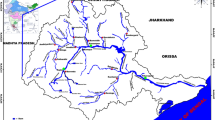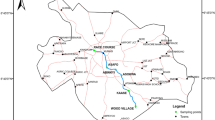Abstract
Different sources of pollution in Karasu Creek were investigated to obtain the water quality and ratio of contamination in this region. To achieve the main objectives of the present study, water samples were collected from Karasu Creek, starting from flow pattern at the upstream site of Akkaya Dam to the end of the dam, crossing the place where the Creek drains into. Dissolved oxygen, electrical conductivity, temperature and maximum/minimum pH were measured systematically for 12 months in the stations, where the water samples were collected. Chemical analyses of the water samples were carried out by using Cadas 50 S brand UV spectrometer to find out the Pb, Fe, Cu, Zn, Ni, Cr, Cd, S, F and Cn concentrations. These concentration were determined in μg/lt as 80–850; 180–4,920; 10–6,100; 440–25,530; 130–2,400; 120–280; 20–150; 214,250–1,113,580; 1,560–4,270 and 40–690, respectively. To determine metal levels of the water samples, multivariate analyses (element coefficient correlation, coefficient correlation dendrogram, hierarchical cluster analysis dendrogram, model summary and ANOVA) were used. The analyses yielded highly accurate results. There were positive correlations between some elements and their possible sources were the same. The stations which resembled each other along the creek were divided into three groups. The water quality of the creek was low and had toxic qualities. Eutrophication developed in Akkaya Dam along the creek. The source of pollution was thought to be industrial and residential wastes. Absolute (0–100 m), short distance (100–500 m) and medium distance (500–2,000 m) conservation areas should be determined in pollution areas along Karasu Creek and they should be improved.
Similar content being viewed by others
References
Alas, A., & Cil, O. S. (2002). Research on water quality parameters in some water sources which supply drinking water for Aksaray Province. Ecology Environment Journal, 11(42), 40–44.
Atabey, E., Goncuoglu, M. C., & Turhan, N. (1990). Kozan J19 map, 1/100.000, Scale Series of Turkey Geology Maps. MTA., no 33, p 28.
Aydin, O. (2004) Investigations for estimating and improving the water quality at Karasu Valley in Nigde. Master’s thesis, Nigde University, 1–75.
Barlas, M. (1995). Evaluation of creek pollution in terms of biologic and chemical aspects and criteria (East Anatolian Region). II. Water Aquacultures Symposium. 465–479.
Bayram, A., Orhan Y., Ozkoc H. B., & Buyukgungor, H. (1997). Research of surface water of Kızılırmak Delta. Priorities of Environmental Pollution in Turkey. Symposium II, 25–27.
Cirik, S. (1995). Limnology (course book). Ege University Aquaculture Faculty Publications, Publication no: 21, 1–166.
Dolgova, Y. E., & Kudryavtseva V. A. (2006). Application of new types of fibrous sorbents for sampling of dissolved species of heavy metals in natural waters. Russian Journal of Applied Chemistry, 79(2), 279–283.
Elhatip, H., Gulbahar, N., & Kurmac, Y. (2001). Environment in Turkey, human and water sources, “Turkey Water Congress” 8–10 January, 2001, İstanbul Technical University, Faculty of Aeronautics and Astronautics, Department of Meteorology Engineering, 67–69.
Göcmez, G. (1997). Hydrogeologic study of Aksaray’s warm and mineral water sources, Aksaray Governor’s Office, Special Provincial Administration and Province Directorate of Tourism. Aksary Ofset Publishing House, 1–190.
Karpuzcu, M. (1991). Environmental pollution and control. Bogazici University, Faculty of Environmental Sciences, 317, Istanbul.
Kurmac, Y. (2003). Detection of water quality of Aksaray Uluırmak and research on rehabilitation. Master’s thesis, Nigde University, 1–123.
Narin, I., & Soylak, M. (1999). Determination of cadmium, copper, lead and nickel contents of water samples from Tabakhane Creek and Akkaya Dam, Nigde—Turkey after preconcentration on activated carbon. Fresenius Environmental Bulletin, 8, 024–027.
Polat, M. (1998). Observed physical and chemical parameters in creeks and lakes, General Directorate of State Hydraulic Works, Seminar notes, 1–23.
Simsek, S. (1997). Geology of Ihlara Private Conservation Area and recommendations on hydrogeological and hydrochemical study of main sources in the region, Aksaray Governor’s Office, Special Provincial Administration and Province Directorate of Tourism, Aksaray Ofset Publishing House, 1–190.
Singh, S., & Kumar, M. (2006). Heavy metal load of soil, water and vegetables in peri-urban Delhi. Environmental Monitoring and Assessment, 120, 79–91.
SKKY (1998). Regulation of water pollution and control, Published in official Gazette 4.9.1988, 19919, 93–98.
Topbas, M., Brohi, A., & Karaman, M. (1998). Environmental pollution. Ministry of Environment Publications, 35–61, 105–111, 141–152.
TSE, Turkish Standards Institution (1984). TS.266.
Tunay, O. (1996). Industrial pollution control symposium. İstanbul University Publications, Publication no: 1578, 64–72.
Uslu, O. (1998). Turkey’s environmental problems. Ankara: Turkey Environment Foundation Publications.
Uslu, O., & Turkman, A. (1987). Water pollution and control, T.C Prime Ministry General Directorate of Environment Publications. Education serie1, p 360.
Vaisanen, U., Misund, A., & Chekushin, V. (1998). Ecogeochemical investigation: Stream water quality as an indicator of pollution in the border areas of Finland, Norway and Russia. Water, Air, and Soil Pollution, 104, 205–219.
WHO (1984). Guidelines for Drinking-WATER Quality, Volume II–III, p 120.
Yalcin, M. G. (1995). Geochemical study of Gumusler (Nigde) region polymetalic antimuan-mercury mineralization. Theis Mc., p. 165.
Yalcin, M. G., Narin, I., & Soylak, M. (2006). Heavy metal contents of the Karasu Creek Sediments. Nigde, Turkey, Environmental Monitoring and Assessment, DOI 10.1007/s10661-006-9318-2, p. 7.
Author information
Authors and Affiliations
Corresponding author
Rights and permissions
About this article
Cite this article
Yalcin, M.G., Aydin, O. & Elhatip, H. Heavy metal contents and the water quality of Karasu Creek in Nigde, Turkey. Environ Monit Assess 137, 169–178 (2008). https://doi.org/10.1007/s10661-007-9737-8
Received:
Accepted:
Published:
Issue Date:
DOI: https://doi.org/10.1007/s10661-007-9737-8




